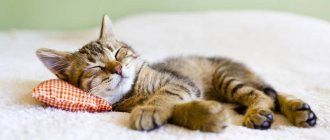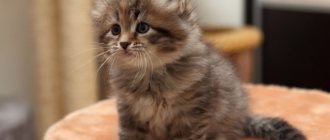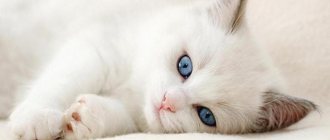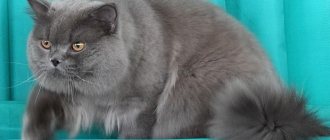History of the Siberian cat breed
The Siberian cat, the photo of which is provided below, is an ancient natural breed. As a result of many studies, it was established that its ancestor is the Bukhara cat, brought to Russia by Asian traders. The animal quickly adapted to the harsh northern conditions, growing a surprisingly warm coat.
Advertising:
Russian merchants contributed to the spread of the breed throughout the country, which is why the Siberian cat could be found both among ordinary peasants and noble individuals. This type of cat was officially recognized only in 1996, forming its standard. Since that time, cats from Siberia have been actively participating in various competitions and exhibitions, and are also in great demand as a favorite pet.
What to look for when buying a Siberian cat
First of all, decide on your plans for your pet, because its cost will largely depend on this. The most budget option is Siberian pet class cats. These are pets for the soul. They have no chance at exhibitions due to minor deviations from standards, although this does not affect the health of the animals in any way.
For breeding, choose kittens from the “breed” class. And for participation in exhibitions and potential titles - “show”. Such Siberian cats have every chance of receiving the highest marks from judges.
Consider all the points when choosing a kitten. Photo: endomassа/Depositphotos
Of course, before buying, you should look at the kitten itself. He must be well-groomed, active, playful, developed for his age and moderately well-fed. Make sure that the future pet responds normally and does not show aggression.
You also need to evaluate the conditions of its detention and make sure that all vaccinations required by age have been completed.
When purchasing a kitten, documents are also given to the new owner along with it. These include a veterinary passport and birth certificate, as well as a purchase and sale agreement. Based on the metric, you can later obtain a pedigree.
It happens that kittens are bought without documents at all, for example, through websites with advertisements or on the market. But then you will not be able to be sure of his heredity and health, and you will hardly be able to contact the seller for advice. If this is your case, first of all give the animal a veterinary passport and all the necessary vaccinations.
It will not be possible to obtain a pedigree for such a Siberian cat, since there is no information about its ancestors. However, if the animal “very much resembles” a purebred animal, but this is not confirmed by anything, you can contact one of the clubs - and with a positive conclusion from experts, the pet will be given a certificate of compliance with the breed.
Description of Siberian cats
The breed belongs to large cats, because it is endowed with an extremely muscular body, powerful chest and neck. Also worth noting in the cat’s appearance are strong limbs and a large fluffy tail.
The cat's head is very large. The ears are medium in size, but are distinguished by small tassels at the tips, which gives the pet a certain wildness. Round eyes, the shade of which can be either blue or green, also attract attention.
Siberian conditions played a major role in the formation of the animal’s coat:
- the fur coat is particularly thick;
- dense undercoat available;
- The structure of the hair itself is hard. This helps cats maintain their heat balance both in summer and winter. True, in winter the coat becomes noticeably longer and forms a small collar around the head.
The Siberian cat, the description of the breed of which does not indicate in any way that it is considered hypoallergenic, does not really cause allergic reactions. This is the main feature of such a furry friend.
Description of the breed
Siberian cats are medium or large in size, proportional in shape, and have a strong, stocky build. Physical maturation lasts quite a long time - up to 3–5 years.
Anatomical features
The table contains the main characteristics of a representative of the Siberian breed:
| Part of the body | Description |
| Head | Medium to large in size, trapezoidal in shape, with a gradual transition from the forehead to the nose, rounded chin, developed cheekbones and full cheeks. |
| Eyes | Large, oval, slightly slanted. Color – green or yellow (not related to coat color). |
| Ears | Medium in size, wide at the base, rounded at the tips, decorated with “lynx” tassels, slightly tilted forward. |
| Frame | Strong, muscular, with a powerful back, voluminous chest and short neck. The silhouette has smooth outlines. |
| Limbs | Thick, muscular, of medium size (the hind legs are longer than the front ones). The paws are large, round in shape, with hair between the pads. |
| Tail | Medium size, wide at the base, narrowed towards the end, evenly pubescent. |
The average weight of a cat is 6–12 kg, females – 3.5–7. The height of an adult (height at the withers) reaches 30–35 cm.
Wool
You can distinguish a purebred cat from an ordinary one by the structure of its coat. In the Siberian individual, the guard hair is dense and harsh. The usual one is soft, prone to the formation of tangles.
Siberians have a medium to long, dense coat with an abundant double undercoat. The collar is pronounced, the hind limbs are “dressed” in fluffy pants. The length and thickness of the coat may vary depending on the season.
Tricolor Siberian cat
Color
Both solid and patterned colors (bicolor, tricolor) are allowed.
Monochrome type
Main shades:
- cream;
- blue;
- ginger;
- black.
With the monochromatic type, there is a uniform distribution of pigment along the entire length of the hair.
Of the intense colors, bright, juicy shades are most preferred. Among light colors, the most delicate tones are valued.
Tortoiseshell
This color is formed by superimposing one shade on another: black on red, blue on cream. The result is a uniform spotted pattern.
Most often it occurs in females.
Male tortoiseshells are rarely born and, as a rule, are not capable of procreation.
Tabby (wild color)
This coloring is one of the most common among Siberians. Wild color is characterized by the alternation of dark and light areas on the guard hair with the formation of one or another pattern on the coat.
There are 3 types of tabby recognized among Siberian cats:
- marble (classic);
- brindle;
- spotted.
The preferred characteristics are rich color and clear pattern.
Siberian cats are not very talkative and do not like noise.
Smoke and silver
With these colors, the guard hair is not completely colored: at the root it has no pigmentation (remains white), closer to the tip it becomes colored. Main shades:
- cream;
- blue;
- ginger;
- black;
- tortoiseshell.
All these color varieties are recognized as the standard.
Gold
The fur coat has this shade if each hair is partially apricot-colored. The golden tone of the coat harmoniously combines with the color of the eyes, giving the cat a special charm.
White
This color is one of the most spectacular. It is rarely found in its pure form, more often in combination with other colors. Among these combinations there are 4 types:
- Wang. White color occupies almost the entire surface of the body, except for the tail and the area behind the ears.
- Harlequin. The main color extends to 2/3–5/6 of the coat. The colored areas are the tail, small spots on the head, back, shoulders and hips.
- Bicolor. The light background occupies 1/3–2/3 of the coat. Ideally, the following should be white: a triangular area on the muzzle, the chest, the abdominal area, and the inner surface of the limbs.
- Spotted color. It is characterized by individual light spots in the neck, chest, abdomen or the presence of one or more small white spots.
The following colors are not allowed by the standard:
- chocolate;
- lilac;
- cinnamon (cinnamon color);
- faun (pale beige);
- Abyssinian tabby.
These colors are not recognized either alone or in combination with white.
Domestic felinologists have identified cats with color-point color into a separate breed called “Neva Masquerade” (not yet recognized internationally).
Siberian Color Point at an exhibition
Rock defects
The disadvantages include the following:
- Too graceful physique:
- elongated body;
- Long neck;
- high limbs;
- small paws.
- Non-standard muzzle:
- flat cheeks;
- high cheekbones;
- weak chin;
- smoothed profile.
- Small, round or deep-set eyes.
- Large or miniature ears, set close together, too pubescent.
- Short or excessively long tail, with poorly developed coat.
- Ragged coat with no shine.
- Poorly or overdeveloped undercoat.
- Absence of hair tufts between fingers.
It has been proven that blue eye color in white Siberians may be associated with deafness.
Features of care and maintenance
There are some nuances to consider when keeping this breed:
- This is a very active animal that occasionally, but still loves to show its wild instincts, so most often this breed is kept in private homes.
- If you keep a Siberian cat in an apartment, then it is advisable to often walk it in the yard, where it can hunt for a mouse or a butterfly.
- In order for a cat living in an apartment not to get bored and be able to play, you need to provide her with a small play corner.
- It is worth purchasing a cat bed, otherwise you will have to frequently clean the furniture from fur mats.
- For walks in large parks, it is advisable to buy a leash.
The Siberian cat is famous for its luxurious coat, but it is also distinguished by its ability to independently care for its fur. However, future owners of the Siberian breed should prepare themselves in advance for regular and thorough care of their furry pet. It would also be a good idea to expand your grooming inventory by purchasing more special long-tooth combs and a slicker brush.
Basic care procedures:
- You need to comb 2-3 times a week. During the molting period, you can do it every day. In order for your pet to tolerate this procedure calmly, you need to accustom him to this from childhood.
- Water procedures can be carried out once every 3 months; moreover, the breed is a water lover. A special shampoo is selected for bathing.
- If you don’t have a scratching post in your home, you should definitely make it a habit to trim your nails. This way the furniture and walls in the apartment will be intact.
- It is necessary to carry out regular ear cleaning. To do this, use a moistened cotton swab.
As you can see, the whole difficulty of care lies only in frequent combing of the cat. The remaining procedures are identical to the care of a simple domestic cat.
Preparation and adaptation
Before you bring a Siberian cat into your home, you need to prepare a place for your new ward. This way you can avoid unpleasant surprises, and it will be easier for your pet to adapt to new conditions.
Before picking up your little Siberian from the nursery, purchase the necessary cat supplies:
- Tray and disposable diapers. Choose a tray that is suitable for the size of your ward. The Siberian kitten must fit completely in the box. Remember that cats of this breed are quite large, so it is better to buy a larger litter box. Place the litter box in a secluded location, but within easy reach of your pet. During the adaptation period, release one team for the Siberian kitten, remove the carpets and cover the floor with disposable diapers. Even a kitten accustomed to a litter box in a new environment can become confused and begin to relieve itself in the wrong place. Just be patient, very soon your tailed pet will start going to the litter box.
- Tray filler. Now there is a huge selection of cat litters. However, not all of them are suitable for a baby's tray. Siberian kittens are known to be fidgety and explorers, so they will probably try the filler “to the teeth.” To prevent your child from choking or poisoning from the filler, choose non-toxic products made from natural raw materials. For example, wood or corn fillers.
- Carrying. Every respectful cat should have at least one carrier. Moreover, in it you will pick up your tailed ward from the nursery. For a Siberian kitten, choose a carrier “for growth”. A container for cats of this breed must be spacious and strong so that the fastenings can support the weight of an adult pet (5-9 kg). For large breed cats, pet supply manufacturers suggest using carriers on wheels. They are equipped with large wheels and are very comfortable for trips or long walks.
- Feed. Before purchasing food, check with the breeder what diet the kitten is accustomed to. The nursery will give you recommendations regarding feeding Siberian cats.
- Bowls for food and water. Buy several devices for feeding your Siberian kitten. Pay attention to the material from which the dishes are made and its quality. Bowls must be suitable for cats and be stable.
- Scratching post. All tailed pets love to sharpen their claws and Siberian cats are no exception. To prevent your child from damaging the furniture, purchase a scratching post in advance or make it yourself.
- Toys. Siberian kittens are active, agile and very inquisitive creatures. To give your pet something to do, buy him a ball, a mouse, or an educational toy.
- Preparations and care products. Siberian cats have a luxurious coat that requires constant care. Therefore, you will need special combs to care for the long hair of your little Siberian.
Once you bring your Siberian kitten home, place the carrier on the floor, open it and close the door to the room. Give him the opportunity to get out of the carrier on his own and start exploring the new room.
Siberian cats have high energy needs, so not a single nook in your home can be hidden from them. These tailed purrs love walks in the fresh air. But remember that cats that walk outside are at risk of infectious diseases and injuries.
If you do not plan to let your Siberian cat outside, try to arrange the apartment in such a way that your ward can realize her potential within four walls. Siberians are good jumpers and can climb anywhere, so keep fragile things away.
So that your Siberian cat can jump around to his heart’s content in your apartment, install special shelving and slides. Remember that Siberian cats need exercise, otherwise they will become overweight.
Siberian cats are extremely intelligent and need intellectual stimulation. A bored Siberian can chew furniture, pass it around and cause mischief in the apartment. To avoid this, encourage active and intellectual games of your tailed pet.
Many breeders recommend getting a pair of Siberian cats. In such a tandem they are never bored. It is preferable that the kittens come from the same litter.
Proper nutrition
The Siberian cat breed is not a picky pet and rarely overeats. An animal can eat both natural food and specialized food, but there are some nuances here.
Genetically, it turns out that a cat better assimilates natural foods rich in protein and carbohydrates. This promotes better development of the animal’s muscle mass.
It is advisable to alternate dry food with canned food, otherwise such food can have a negative impact on the cat’s health, in particular on the state of the digestive system.
What is suitable from natural food:
- porridge (buckwheat, rice);
- vegetables (preferably served in the form of puree and mixed with porridge or meat products);
- lean meat (raw or boiled);
- fish (exclusively boiled);
- egg (preferably once a week, raw or boiled can be used);
- low-fat fermented milk products (cottage cheese, kefir).
The Russian Siberian cat eats 2 times a day. A serving of 200-300 g is enough for her to replenish her strength. When calculating portions, it is also worth considering the size of the pet.
History of the breed
There are at least two versions regarding the origin of Siberian cats. There is an opinion that Siberians appeared as a result of mass crossings of some wild taiga cats with domestic cats. According to the second version, the distant ancestors of the Siberian cat came to these lands from the East along with numerous caravans of merchants who were forced to carry fighting cats with them in order to protect their property from hordes of mice and rats.
The Siberian cat has an impressive appearance
The “merchant” offspring remained in Siberia, and then the forces of natural selection came into play - in harsh natural conditions, a special psycho-phenotype of the Siberian cat was gradually formed, a truly unique animal in many of its qualities. Felinologists agree that the origin of the breed can be dated around the end of the sixteenth century.
For a long time these cats were called Bukhara, then for some reason Moscow, and only relatively recently did they receive their current name. They have repeatedly become heroes of Russian folk tales and literary works - for example, the well-known Scientist Cat from Alexander Pushkin is clearly of Siberian origin.
The black Siberian cat is a character in many fairy tales and mystical stories.
People's cat of Russia
One way or another, in large areas of the Urals and Trans-Urals a fairly large population of interesting animals developed, on the basis of which breed selection subsequently took place. From Siberia, charismatic cats began their victorious march across the Eurasian continent, and then across others.
Thanks to the consistent actions of enthusiasts and systematic breeding work, the Siberian cat has received well-deserved recognition throughout the world. At the end of the eighties of the last century, Moscow, Leningrad and Riga nurseries made a great contribution to the formation of the breed. In the Kotofey club in 1987, its first standard was created, which has since undergone some changes, and five years later the World Organization of Cat Fanciers included the breed in its official lists.
Siberian cats are well adapted to harsh climates
The popularity of Siberian cats among the people was incredibly high, especially given the recent shortage of all other cat breeds. Luxurious fluffy beauties walked proudly through courtyards and streets, delighted their owners, caught mice, gave birth to kittens “out of love,” and no one really thought about such concepts as the gene pool and purity of the breed. Although, perhaps, such democracy has benefited her - fresh blood is still pouring into the breed.
Interestingly, the breed remains open to this day. Any foundling phenotypically similar to a Siberian can receive a certificate of belonging to the breed - a registered pedigree - if it is awarded a club referral to an exhibition and earns at least two “excellent” ratings there. There are very real stories of cats picked up in a trash heap who became titled producers, and a cat of the same street origin named Mars even received the title of World Champion.
Health of Siberians
Evolution had a good influence on the formation of this breed, endowing them with good health and strong immunity. Their natural appearance allowed us to avoid many problems typical of other purebred cats.
Despite this, the owner is simply obliged to monitor the health of his pupil:
- Get routine check-ups with a veterinarian.
- Get vaccinated.
- Drive away worms.
Diseases and treatment
What can cats get sick with?
- Rabies. This disease is most often fatal if you do not get vaccinated on time.
- Conjunctivitis. If you manage to notice the symptoms in time, you can avoid unpleasant consequences. Many veterinarians recommend drops for conjunctivitis as a preventative measure.
- Worms are the most common problem for the Siberian breed. A long coat attracts fleas and ticks, so your pet should be checked frequently for the presence of unwanted parasites.
With any treatment, it is important to check the cat for allergic reactions.
Table: pros and cons of the Siberian breed
| Breed Features | pros | Minuses |
| Character | Calm and balanced | Sometimes vindictive, vindictive and aggressive |
| Content | Easy to maintain and care | Requires regular brushing and walking |
| Nutrition | Can eat both ready-made food and natural food | Tends to overeat and is picky about food |
| Health | High resistance to diseases | Predisposition to joint pathologies |
Colors
This breed comes in a wide variety of shades. Chocolate, Burmes and cinnamon colors are considered undesirable. White color and colorpoint is a separate subspecies - Neva Masquerade. Let’s see what the Siberian cat breed looks like in different shades in the photo.
Tortoiseshell or tabby cake
This color is presented in the form of mosaic spots, the main shades of which are cream and red. The spots should be scattered chaotically and not create patterns.
Tabby
This wild shade is presented in the form of light brown or gray stripes or spots. Thanks to this color, cats are able to camouflage well while hunting.
Smoky and silver or smokey silver
The Siberian blue cat with a silvery tint has its own special charm. Smooth transitions of gray shades should not create patterns on the body.
Gold
This noble color is presented in the form of a warm apricot shade. Golden cats usually have clear green eyes.
White
White Siberian cats are often compared to the Turkish Angora, because even their eye color can range from green to sky blue.
Bicolor
This is a combination of two shades. It can be plain with white or tortoiseshell with interesting white inserts.
Colorpoint
Point cats are presented in delicate colors with spots of various shades.
Tabby points
This shade includes dark brown, cream and tortoiseshell points.
Breeding work
The global popularity of the Siberian cat is growing, and breeding nurseries, engaged in breeding, are moving towards improving the breed. The so-called traditional colors and the Neva masquerade cat (Siberian colorpoint) have recently become the most popular - many breeders specialize in these varieties of Siberians.
Neva Masquerade - the fruit of love between Siberian and Siamese cats
The Neva Masquerade cat is a young independent breed created on the basis of the Siberian cat; it combines all six varieties of point colors, which are unacceptable according to the Siberian breed standard. Initially, these blue-eyed fluffy cats appeared as a result of the hybridization of Siberian and Siamese breeds, but in many respects they are still classified as Siberians.
Breeding Features
Siberian cats are endowed with very strong genetics and an amazing ability to reproduce. They are prolific - one litter can have from five to ten kittens, which almost never happens in other breeds. Male Siberians do not lose their reproductive qualities until they are eleven or twelve years old, and females do not lose their reproductive qualities until they are eighteen years old. Of course, at this age, owners should not allow offspring to appear - this is too difficult for an elderly animal.
Siberian cats retain reproductive abilities into old age
The selection of healthy sires with good heredity plays a primary role in breeding work. In addition, for breeding Siberian cats it is very important to navigate the genetics of colors, which are so richly represented in this breed.
Table: possible colors of Siberian kittens in the litter
| Cat | Cat | Kittens-cats | Kitten cats |
| Black | Black | Black Blue | Black Blue |
| Blue | Black Blue | Black Blue | |
| Red | Red Cream | Tortoiseshell Blue-cream | |
| Tortoiseshell Blue-cream | Cream | Red Cream | |
| Tortoiseshell | Black Blue Red Cream | Black Blue Tortoise Blue-cream | |
| Blue-cream | Black Blue Red Cream | Black Blue Tortoise Blue-cream | |
| Blue | Black | Black Blue | Black Blue |
| Blue | Blue | Blue | |
| Red | Red Cream | Tortoiseshell Blue-cream | |
| Cream | Cream | Blue-cream | |
| Tortoiseshell | Black Blue Red Cream | Black Blue Tortoise Blue-cream | |
| Blue-cream | Blue Cream | Blue Blue-cream | |
| Red | Black | Black Blue | Tortoiseshell Blue-cream |
| Blue | Black Blue | Tortoiseshell Blue-cream | |
| Red | Red cream | Red Cream | |
| Cream | Red cream | Red Cream | |
| Tortoiseshell | Black Blue Red Cream | Red Cream Tortoise Blue Cream | |
| Blue-cream | Black Blue Red Cream | Red Cream Tortoise Blue Cream | |
| Cream | Black | Black Blue | Tortoiseshell Blue-cream |
| Blue | Blue | Blue-cream | |
| Red | Red cream | Red Cream | |
| Cream | Cream | Cream | |
| Tortoiseshell | Black Blue Red Cream | Red Cream Tortoise Blue Cream | |
| Blue-cream | Blue Cream | Cream Blue-cream |
The genetics of colors are not random accidents
In what cases is sterilization necessary?
The main argument for sterilizing an animal can only be medical indications when it comes to its health or even life. Also, sterilization or castration may become a condition of the breeder when selling a kitten, which he does not consider possible to allow for breeding. It is also impossible to obtain offspring from overly aggressive animals - in such cases, sterilization usually reduces the level of hostility.
All other situations must be carefully analyzed to determine the advisability of the operation - surgery is performed under general anesthesia and can be fraught with serious complications.
Character
The Siberian cat has a calm and friendly character, which makes the cat a good companion. Representatives of this breed are very sociable and become strongly attached to their owner. This feature has its pros and cons:
- If you are unable to provide your cat with the attention it deserves, your pet will be bored.
- On the other hand, a cat can become your most faithful friend who will accompany you for the rest of its life.
Siberians are often compared to a dog: the cat is distrustful of strangers, can defend its territory, and is wary of loud extraneous sounds.
The Siberian cat perceives other animals in the apartment as competition. He shows calmness and patience towards children, loves to play pranks and play with them.
The breed is distinguished by a sharp mind; they are smart enough to quickly perceive new information. Thanks to this, cats easily learn the rules of a new home.
Choosing a kitten
You can adopt a kitten when it is 2.5 months old. At this age, he can already do without his mother. Before his arrival you need to prepare:
- bowls for food and water;
- a house or a resting bed;
- scratching post;
- litter tray with filler.
Choosing a kitten begins with meeting the mother cat. She must be well-groomed and correspond to the Siberian type. The baby should not have even a hint of illness. A good kitten is moderately active and curious. There is no need to take the calmest or most mischievous kitten. In this case, the best is the golden mean.
Before three months it is impossible to determine who will be the best representative of the breed. It can be difficult to pre-determine future features even before 5–7 months. But if exhibition standards are not important, just choose the one you like best.
A responsible breeder, together with the kitten, gives the new owner the kitten’s usual food, litter and recommendations for feeding and care. He must inform about the vaccinations and manipulations against worms.











